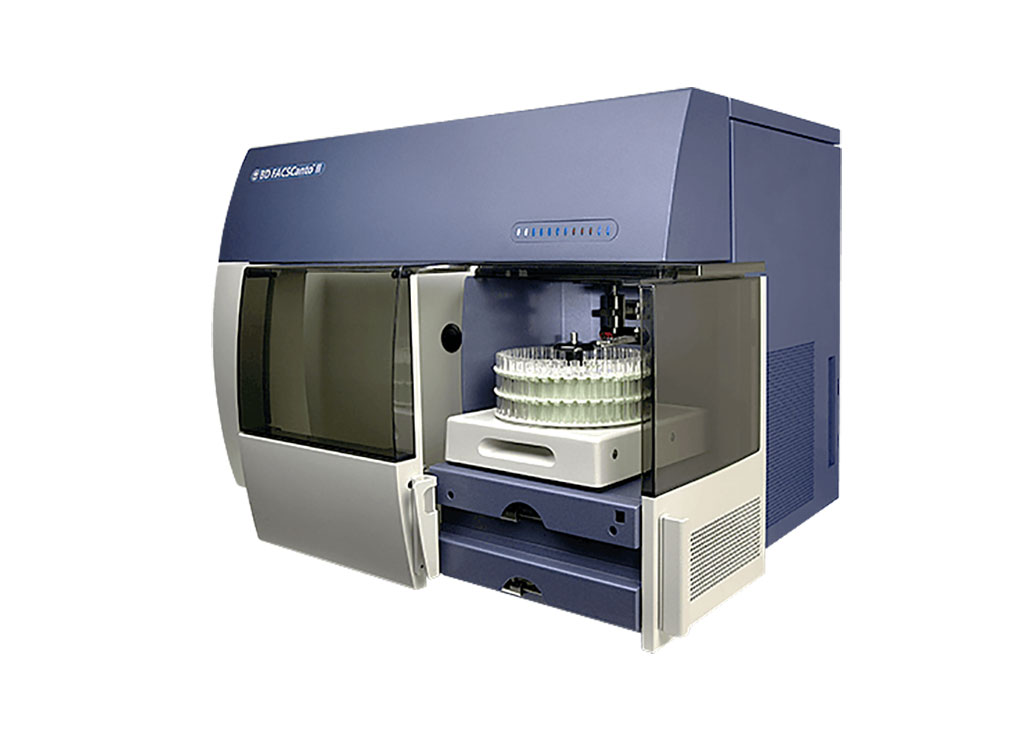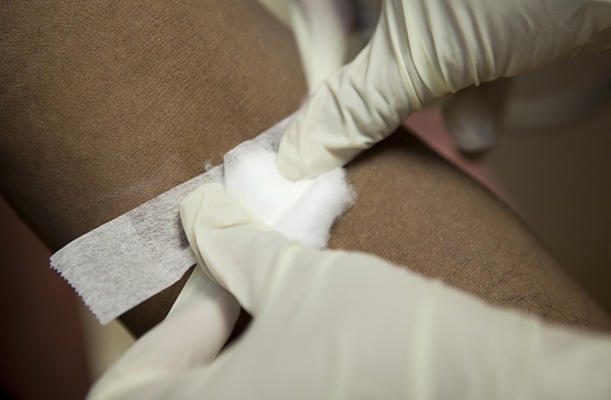Tissue Counterpart to Monoclonal B-Cell Lymphocytosis Characterized
|
By LabMedica International staff writers Posted on 21 Apr 2021 |

Image: BD FACSCanto II flow cytometer (Photo courtesy of BD Biosciences)
Monoclonal B-cell lymphocytosis (MBL) was initially proposed to recognize patients with a monotypic B cell population identified by peripheral blood (PB) flow cytometry (FC) that did not meet numerical criteria for chronic lymphocytic leukemia (CLL).
While MBL is defined in the blood, pathologists encounter rare cases in which a monotypic B-cell population is detected in biopsy tissue undergoing FC without obvious morphologic involvement by lymphoma (referred to as tMBL). Most, if not all, cases of CLL are preceded by MBL.
Medical Laboratory Scientists at the Cleveland Clinic (Cleveland, OH, USA) retrospectively identified non–bone marrow/peripheral blood cases with monotypic B cells detected by tissue-based flow cytometry, but without an identifiable lymphomatous infiltrate on routine histopathology during a 10 year period. They excluded cases with prior diagnosis of chronic lymphocytic leukemia (CLL)/small lymphocytic lymphoma or MBL. Flow cytometry was performed in-house on 31 cases (6-color FC, 0.04% sensitivity; BD FACSCanto, (BD Biosciences, San Jose, CA, USA) or was performed at outside reference laboratories.
The scientists identified 54 cases (35 lymph node, three splenic, and 16 soft tissue/viscera). Forty-six cases were CLL-type, two were atypical CLL, and six were non-CLL. tMBL was detectable by immunohistochemistry in 14 cases (26%, all CLL-type). Concurrent blood flow cytometry, available in 10 cases, showed four with low-count MBL (3 CLL-type, one with non-CLL–type), five with high-count MBL (all CLL-type), and one case negative for clonal population. With median follow-up of 51 months, two patients had progression of disease (CLL, 68.7 months; and diffuse large B-cell lymphoma, 5.9 months). Patients with immunohistochemistry-detectable tMBL had increased monoclonal B cells per total lymphocyte events, morphologic evidence of bone marrow involvement, higher white blood cell count, and increased absolute lymphocyte count.
The authors concluded that tMBL spans an immunophenotypic spectrum similar to MBL, is detectable by immunohistochemistry in a minority of cases (often CLL immunophenotype), and is likely systemic in most cases. Development of overt lymphoma is uncommon but may occur, warranting clinical follow-up. The study was published on March 15, 2021 in the journal Archives of Pathology and Laboratory Medicine.
Related Links:
Cleveland Clinic
BD Biosciences
While MBL is defined in the blood, pathologists encounter rare cases in which a monotypic B-cell population is detected in biopsy tissue undergoing FC without obvious morphologic involvement by lymphoma (referred to as tMBL). Most, if not all, cases of CLL are preceded by MBL.
Medical Laboratory Scientists at the Cleveland Clinic (Cleveland, OH, USA) retrospectively identified non–bone marrow/peripheral blood cases with monotypic B cells detected by tissue-based flow cytometry, but without an identifiable lymphomatous infiltrate on routine histopathology during a 10 year period. They excluded cases with prior diagnosis of chronic lymphocytic leukemia (CLL)/small lymphocytic lymphoma or MBL. Flow cytometry was performed in-house on 31 cases (6-color FC, 0.04% sensitivity; BD FACSCanto, (BD Biosciences, San Jose, CA, USA) or was performed at outside reference laboratories.
The scientists identified 54 cases (35 lymph node, three splenic, and 16 soft tissue/viscera). Forty-six cases were CLL-type, two were atypical CLL, and six were non-CLL. tMBL was detectable by immunohistochemistry in 14 cases (26%, all CLL-type). Concurrent blood flow cytometry, available in 10 cases, showed four with low-count MBL (3 CLL-type, one with non-CLL–type), five with high-count MBL (all CLL-type), and one case negative for clonal population. With median follow-up of 51 months, two patients had progression of disease (CLL, 68.7 months; and diffuse large B-cell lymphoma, 5.9 months). Patients with immunohistochemistry-detectable tMBL had increased monoclonal B cells per total lymphocyte events, morphologic evidence of bone marrow involvement, higher white blood cell count, and increased absolute lymphocyte count.
The authors concluded that tMBL spans an immunophenotypic spectrum similar to MBL, is detectable by immunohistochemistry in a minority of cases (often CLL immunophenotype), and is likely systemic in most cases. Development of overt lymphoma is uncommon but may occur, warranting clinical follow-up. The study was published on March 15, 2021 in the journal Archives of Pathology and Laboratory Medicine.
Related Links:
Cleveland Clinic
BD Biosciences
Latest Pathology News
- AI Tool Improves Accuracy of Skin Cancer Detection
- Highly Sensitive Imaging Technique Detects Myelin Damage
- 3D Genome Mapping Tool to Improve Diagnosis and Treatment of Genetic Diseases
- New Molecular Analysis Tool to Improve Disease Diagnosis
- Tears Offer Noninvasive Alternative for Diagnosing Neurodegenerative Diseases
- AI-Powered Method Combines Blood Data to Accurately Measure Biological Age
- AI Tool Detects Cancer in Blood Samples In 10 Minutes
- AI Pathology Analysis System Delivers Comprehensive Cancer Diagnosis
- AI Improves Cervical Cancer Screening in Low-Resource Settings
- New Multi-Omics Tool Illuminates Cancer Progression
- New Technique Detects Genetic Mutations in Brain Tumors During Surgery within 25 Minutes
- New Imaging Tech to Improve Diagnosis and Treatment of Skin Cancers
- Serially Testing Brain Tumor Samples Reveals Treatment Response in Glioblastoma Patients
- High-Accuracy Tumor Detection Method Offers Real-Time Surgical Guidance
- AI Tool Detects Hidden Warning Signs of Disease Inside Single Cells
- Automated Tool Detects Early Warning Signs of Breast Cancer
Channels
Clinical Chemistry
view channel
VOCs Show Promise for Early Multi-Cancer Detection
Early cancer detection is critical to improving survival rates, but most current screening methods focus on individual cancer types and often involve invasive procedures. This makes it difficult to identify... Read more
Portable Raman Spectroscopy Offers Cost-Effective Kidney Disease Diagnosis at POC
Kidney disease is typically diagnosed through blood or urine tests, often when patients present with symptoms such as blood in urine, shortness of breath, or weight loss. While these tests are common,... Read moreMolecular Diagnostics
view channel
Simultaneous Analysis of Three Biomarker Tests Detects Elevated Heart Disease Risk Earlier
Accurately identifying individuals at high risk of heart attack remains a major challenge, especially when traditional indicators like cholesterol and blood pressure appear normal. Elevated levels of three... Read more
New Biomarker Panel to Improve Heart Failure Diagnosis in Women
Heart failure affects millions worldwide, yet many women are still misdiagnosed or diagnosed too late. Although heart failure broadly means the heart cannot pump enough blood to the body’s cells, its two... Read moreImmunology
view channel
Chip Captures Cancer Cells from Blood to Help Select Right Breast Cancer Treatment
Ductal carcinoma in situ (DCIS) accounts for about a quarter of all breast cancer cases and generally carries a good prognosis. This non-invasive form of the disease may or may not become life-threatening.... Read more
Blood-Based Liquid Biopsy Model Analyzes Immunotherapy Effectiveness
Immunotherapy has revolutionized cancer care by harnessing the immune system to fight tumors, yet predicting who will benefit remains a major challenge. Many patients undergo costly and taxing treatment... Read moreMicrobiology
view channel
15-Minute Blood Test Diagnoses Life-Threatening Infections in Children
Distinguishing minor childhood illnesses from potentially life-threatening infections such as sepsis or meningitis remains a major challenge in emergency care. Traditional tests can take hours, leaving... Read more
High-Throughput Enteric Panels Detect Multiple GI Bacterial Infections from Single Stool Swab Sample
Gastrointestinal (GI) infections are among the most common causes of illness worldwide, leading to over 1.7 million deaths annually and placing a heavy burden on healthcare systems. Conventional diagnostic... Read morePathology
view channel
AI Tool Improves Accuracy of Skin Cancer Detection
Diagnosing melanoma accurately in people with darker skin remains a longstanding challenge. Many existing artificial intelligence (AI) tools detect skin cancer more reliably in lighter skin tones, often... Read more
Highly Sensitive Imaging Technique Detects Myelin Damage
Damage to myelin—the insulating layer that helps brain cells function efficiently—is a hallmark of many neurodegenerative diseases, age-related decline, and traumatic injuries. However, studying this damage... Read moreTechnology
view channel
AI-Powered Biosensor Technology to Enable Breath Test for Lung Cancer Detection
Detecting lung cancer early remains one of the biggest challenges in oncology, largely because current tools are invasive, expensive, or unable to identify the disease in its earliest phases.... Read more
AI Model Achieves Breakthrough Accuracy in Ovarian Cancer Detection
Early diagnosis of ovarian cancer remains one of the toughest challenges in women’s health. Traditional tools such as the Risk of Ovarian Malignancy Algorithm (ROMA) can struggle to distinguish between... Read more
Portable Biosensor Diagnoses Psychiatric Disorders Using Saliva Samples
Early diagnosis of psychiatric disorders such as depression, schizophrenia, and bipolar disorder remains one of medicine’s most pressing challenges. Current diagnostic methods rely heavily on clinical... Read more
Cell-Sorting Device Uses Electromagnetic Levitation to Precisely Direct Cell Movement
Sorting different cell types—such as cancerous versus healthy or live versus dead cells—is a critical task in biology and medicine. However, conventional methods often require labeling, chemical exposure,... Read moreIndustry
view channel
Co-Diagnostics Forms New Business Unit to Develop AI-Powered Diagnostics
Co-Diagnostics, Inc. (Salt Lake City, UT, USA) has formed a new artificial intelligence (AI) business unit to integrate the company's existing and planned AI applications into its Co-Dx Primer Ai platform.... Read more










 Analyzer.jpg)













